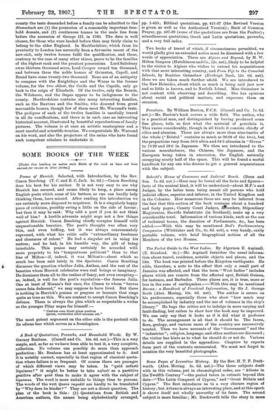HERTFORDSHIRE FAMILIES.
Hertfordshire Families. By Duncan Worland, M.A. " Victoria County Histories," Genealogical Volumes. (A. Constable and Co. 1.5 65. net.)—The second volume of this sumptuous series well bears out the promise of the first. A year ago, in reviewing Mr. Barron's volume on "Northamptonshire Families," wo called attention to the revolution which it was likely to make in current methods of genealogical science. Mr. Duncan Warrand ably continues the same tradition, and his work is a model of scholarly accuracy and lucidity. The principle adopted is that the basis of nobility—at least of English nobility—is not the bearing of arms, bal the owning of lands. Accordingly in every
county the tests demanded before a family can be admitted to the Staimnbuth are (1) the possession of a reasonably important free- hold domain, and (2) continuous tenure in the male line from before the accession of George III. in 1760. The date is well chosen, for those who were landed before then map fairly claim to belong to the older England. In Hertfordshire, which from its proximity to London has naturally been a favourite resort of the new-rich, only twelve houses fulfil the qualification, and these, contrary to the case of many other shires, prove to be the families of the highest rank and the greatest possessiOns. Lord Salisbury owns thirteen thousand acres, Lord Cowper owned ten thousand, and between them the noble houses of Grimston, Capell, and Brand have some twenty-two thousand. None are of an antiquity to compare with the Knightleys and the Wares in the former volume, for the two oldest, the Cecils and the Capella, only go back to the reign of Elizabeth. Of the twelve, only the Brands, the Wilsheres, and the Gapes appear to be indigenous to the county. Hertfordshire contains also many interesting families, such as the Buxton, and the Smiths, who descend from great mercantile houses, though few of them meet Mr. Warrand's tests. The pedigree of each of the twelve families is carefully traced in all its ramifications, and there is in each case an interesting historical account, illustrated by beautiful reproductions of family pictures. The volume is at once an artistic masterpiece and a most careful and scientific treatise. We congratulate Mr. Warrand on his work, and also the projectors of the series who have found such competent scholars to undertake it.











































 Previous page
Previous page